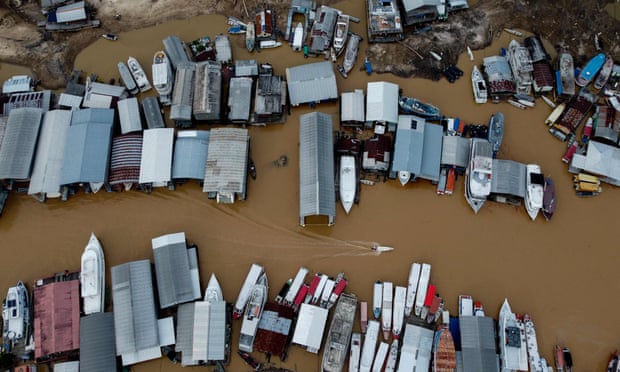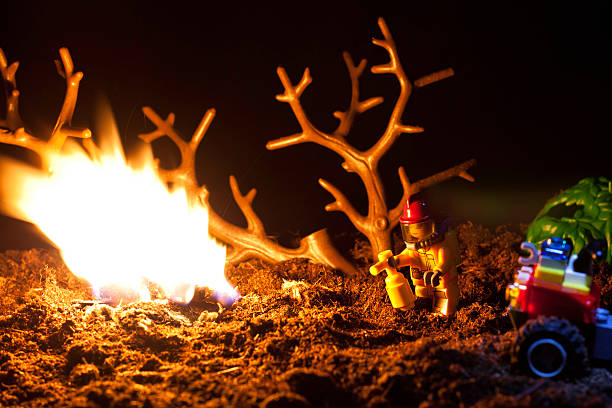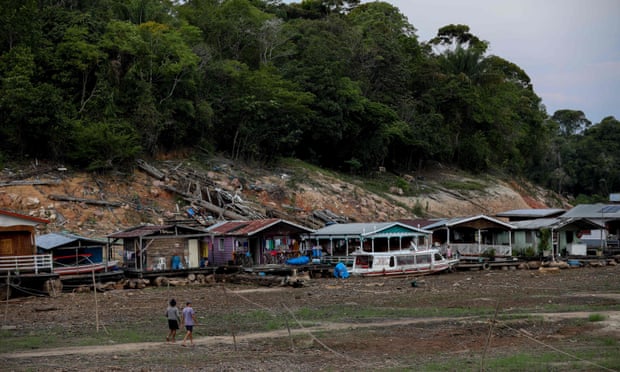- Joined
- Jan 17, 2010
- Messages
- 4,522
- Reaction score
- 5,489
Forest fires leave Manaus with second worst air quality in the world, while low river levels cut off communities

Rivers are the only means of access in many parts of the Amazon. Photograph: Michael Dantas/AFP/Getty Images
A withering drought has turned the Amazonian capital of Manaus into a climate dystopia with the second worst air quality in the world and rivers at the lowest levels in 121 years.
The city of 1 million people, which is surrounded by a forest of trees, normally basks under blue skies. Tourists take pleasure boats to the nearby meeting of the Negro and Amazon (known locally as the Solimões) rivers, where dolphins can often be seen enjoying what are usually the most abundant freshwater resources in the world.

But an unusually dry season, worsened by an El Niño and human-driven global heating, has threatened the city’s self-image, the wellbeing of its residents and the survival prospects for the entire Amazon basin.
The forest capital has been enveloped in a murky brown haze reminiscent of China during its most polluted phase. The usually vibrant port has been pushed far out across the dried-up, rubbish-strewn mud flats.
/i.s3.glbimg.com/v1/AUTH_59edd422c0c84a879bd37670ae4f538a/internal_photos/bs/2021/R/5/L5O9yzRaCsp2BHdBaUrw/museu-imaginacao-fto-5575-fabio-tito-g1.jpg)
So many fires are burning in the surrounding tinder-dry forest that air-quality monitors last week registered 387 micrograms of pollution a cubic metre, compared with 122 in Brazil’s economic capital of São Paulo. The only city in the world that measured worse was an industrial centre of Thailand.
A recent front page of the A Crítica newspaper showed a photograph of the drought-stricken port under the headline “Health in peril” and a story about the challenges of securing medicines and essential resources at a time when goods ships could not navigate the river. “Boiling Amazon” read the lead story of Cenarium magazine, which noted the unusually high heat and low humidity that have created dangerously dry conditions in the forest.
The drought has affected swathes of Brazil. The state of Amazonas has recorded 2,770 fires during the current dry season, which local media said was the highest recorded.
Although more droughts and fires than usual were to be expected in El Niño years such as this, local firefighting services were ill-prepared and ill-equipped.
The secretary of Borba town, said: “If municipalities had even the minimum structure in place, we could have avoided many problems.”
Jane Crespo, the environmental secretary of Maués, a community 155 miles (250km) from Manaus, said: “Some municipalities don’t have enough water to put out the fires.”

Floating houses and boats stranded at the Marina do Davi, a docking area of the Negro river, in Manaus. Photograph: Michael Dantas/AFP/Getty Images
Rivers are the only means of access in many parts of the Amazon. As their levels have fallen, some communities have been cut off, raising concerns of a humanitarian disaster. Elsewhere, navigation is only possible by small boats, which make transport more expensive. At Tabatinga, Benjamin Constant and Atalaia do Norte, people complain that goods are becoming more expensive.
Factory production has also been hit by the lack of supplies, threatening the economy of Manaus and its reputation as a free-trade zone. Amazonas state authorities have called an emergency meeting to discuss the regional climate crisis and appealed to the federal government for assistance.

Road industry lobbyists are using the crisis to push demands for a new paved road – the controversial BR 319 – that would link Manaus to Porto Velho. Amazon conservationists warn this would be a disaster for one of the last remaining areas of globally important and intact forest.
The impact on other species is likely to be devastating. As well as the mass deaths of endangered river dolphins, countless other species are likely to be experiencing mortalities. The Manaus-based mycologist Noemia Ishikawa said she had noticed an almost total absence of mushrooms in the fields.

Philip Fearnside, a senior researcher at the National Institute for Amazonian Research, warned the rainforest was moving closer to a point of irreversible decline as dry seasons lengthen, along with more days of extreme heat and no rain.
Adding to the risks is a growing human population that is converting more forest into pasture, which is regularly burned. Fearnside said: “All of the tree deaths from these processes can contribute to initiating a vicious cycle, where the dead wood left in the forest serves as fuels for forest fires, which are both more likely to start and spread and are more intense and damaging if they occur.

“Repeated fires can destroy the forest entirely. In addition to tipping points in terms of temperature and dry-season length, there is also a tipping point from the loss of forest beyond a certain limit, which is also believed to be near at hand.”
Brief periods of upriver rain in recent days have raised hopes the dry season may be drawing to an end, but meteorologists say it is too soon to predict that with any confidence. However, climate trends make it almost certain that this drought will not be a record for long.
https://www.theguardian.com/environ...limate-manaus-forest-fires-air-quality-rivers
- Sugested reads:
https://edition.cnn.com/2023/10/17/...lowest-levels-drought-climate-intl/index.html
https://www.reuters.com/world/ameri...ater-level-121-years-amid-drought-2023-10-16/

Rivers are the only means of access in many parts of the Amazon. Photograph: Michael Dantas/AFP/Getty Images
A withering drought has turned the Amazonian capital of Manaus into a climate dystopia with the second worst air quality in the world and rivers at the lowest levels in 121 years.
The city of 1 million people, which is surrounded by a forest of trees, normally basks under blue skies. Tourists take pleasure boats to the nearby meeting of the Negro and Amazon (known locally as the Solimões) rivers, where dolphins can often be seen enjoying what are usually the most abundant freshwater resources in the world.

But an unusually dry season, worsened by an El Niño and human-driven global heating, has threatened the city’s self-image, the wellbeing of its residents and the survival prospects for the entire Amazon basin.
The forest capital has been enveloped in a murky brown haze reminiscent of China during its most polluted phase. The usually vibrant port has been pushed far out across the dried-up, rubbish-strewn mud flats.
/i.s3.glbimg.com/v1/AUTH_59edd422c0c84a879bd37670ae4f538a/internal_photos/bs/2021/R/5/L5O9yzRaCsp2BHdBaUrw/museu-imaginacao-fto-5575-fabio-tito-g1.jpg)
So many fires are burning in the surrounding tinder-dry forest that air-quality monitors last week registered 387 micrograms of pollution a cubic metre, compared with 122 in Brazil’s economic capital of São Paulo. The only city in the world that measured worse was an industrial centre of Thailand.
A recent front page of the A Crítica newspaper showed a photograph of the drought-stricken port under the headline “Health in peril” and a story about the challenges of securing medicines and essential resources at a time when goods ships could not navigate the river. “Boiling Amazon” read the lead story of Cenarium magazine, which noted the unusually high heat and low humidity that have created dangerously dry conditions in the forest.
The drought has affected swathes of Brazil. The state of Amazonas has recorded 2,770 fires during the current dry season, which local media said was the highest recorded.
Although more droughts and fires than usual were to be expected in El Niño years such as this, local firefighting services were ill-prepared and ill-equipped.
The secretary of Borba town, said: “If municipalities had even the minimum structure in place, we could have avoided many problems.”
Jane Crespo, the environmental secretary of Maués, a community 155 miles (250km) from Manaus, said: “Some municipalities don’t have enough water to put out the fires.”

Floating houses and boats stranded at the Marina do Davi, a docking area of the Negro river, in Manaus. Photograph: Michael Dantas/AFP/Getty Images
Rivers are the only means of access in many parts of the Amazon. As their levels have fallen, some communities have been cut off, raising concerns of a humanitarian disaster. Elsewhere, navigation is only possible by small boats, which make transport more expensive. At Tabatinga, Benjamin Constant and Atalaia do Norte, people complain that goods are becoming more expensive.
Factory production has also been hit by the lack of supplies, threatening the economy of Manaus and its reputation as a free-trade zone. Amazonas state authorities have called an emergency meeting to discuss the regional climate crisis and appealed to the federal government for assistance.

Road industry lobbyists are using the crisis to push demands for a new paved road – the controversial BR 319 – that would link Manaus to Porto Velho. Amazon conservationists warn this would be a disaster for one of the last remaining areas of globally important and intact forest.
The impact on other species is likely to be devastating. As well as the mass deaths of endangered river dolphins, countless other species are likely to be experiencing mortalities. The Manaus-based mycologist Noemia Ishikawa said she had noticed an almost total absence of mushrooms in the fields.

Philip Fearnside, a senior researcher at the National Institute for Amazonian Research, warned the rainforest was moving closer to a point of irreversible decline as dry seasons lengthen, along with more days of extreme heat and no rain.
Adding to the risks is a growing human population that is converting more forest into pasture, which is regularly burned. Fearnside said: “All of the tree deaths from these processes can contribute to initiating a vicious cycle, where the dead wood left in the forest serves as fuels for forest fires, which are both more likely to start and spread and are more intense and damaging if they occur.

“Repeated fires can destroy the forest entirely. In addition to tipping points in terms of temperature and dry-season length, there is also a tipping point from the loss of forest beyond a certain limit, which is also believed to be near at hand.”
Brief periods of upriver rain in recent days have raised hopes the dry season may be drawing to an end, but meteorologists say it is too soon to predict that with any confidence. However, climate trends make it almost certain that this drought will not be a record for long.
https://www.theguardian.com/environ...limate-manaus-forest-fires-air-quality-rivers
- Sugested reads:
https://edition.cnn.com/2023/10/17/...lowest-levels-drought-climate-intl/index.html
https://www.reuters.com/world/ameri...ater-level-121-years-amid-drought-2023-10-16/

